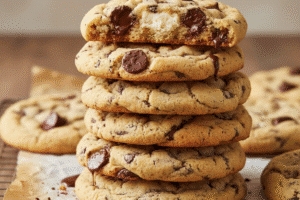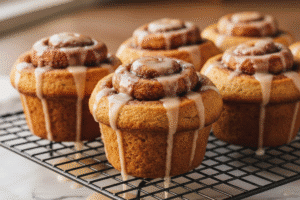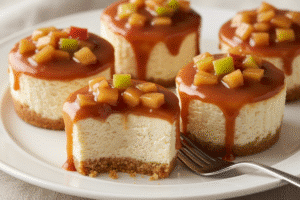This peppermint tea recipe is my go-to whenever that familiar mid-afternoon slump hits. Instead of reaching for more coffee, I like to make something gentle and refreshing. A handful of fresh peppermint leaves, hot water, and a quiet minute are often enough to help me feel more awake and centered.
If you’re looking for a natural, caffeine-free drink that may support a clearer, calmer moment, this fresh peppermint tea recipe is a simple one to try. I’ll show you exactly how to make it at home and share a little trick that brings out the best flavor from your herbs. And if you want another light, energizing afternoon option, this banana strawberry blueberry smoothie is a great choice.
Table of Contents
Why You’ll Love This Peppermint Tea Recipe
It’s Naturally Refreshing and Energizing
Made with fresh peppermint leaves, this tea has a crisp, cooling flavor that wakes up your senses. It’s perfect for a mid-day reset or a gentle way to start your morning without caffeine.
Supports Focus and Mental Clarity
With the optional touch of rosemary, this blend may help you feel more alert and focused. Many people enjoy these herbs for their refreshing aroma and clear-headed feel, making this tea a nice alternative when you want something calming instead of coffee.
Easy to Make, Impossible to Mess Up
If you’re new to herbal teas, this recipe is wonderfully forgiving. With just water, fresh mint, and simple add-ins like honey or lemon, it always turns out soothing and bright.
Versatile: Enjoy It Hot or Cold
If you’re craving something cool, you can easily turn it into an iced peppermint tea by pouring it over ice. It tastes just as refreshing chilled.
Gentle and Light
This peppermint tea is naturally caffeine-free and can be made with little to no added sugar. It’s a simple, feel-good beverage you can enjoy any time of day.
What You’ll Need for This Peppermint Tea Recipe
Fresh Peppermint Leaves: The Star of the Show
Fresh peppermint gives this tea its bold, cooling flavor. The natural menthol in the leaves creates that refreshing aroma and clean taste peppermint is known for. Peppermint is also widely enjoyed for its soothing feel, and you can read more about its commonly discussed benefits in this Healthline overview.
Water, Just Off the Boil
Using water that’s just off the boil (around 200°F) helps the herbs release their flavor without turning bitter. This small detail makes a noticeable difference in the final cup.
Optional Rosemary Sprig: For a Clear, Fresh Aroma
A small sprig of rosemary pairs beautifully with peppermint. Many people enjoy this combo for its bright, uplifting scent and the way it helps them feel more focused while sipping.
Natural Sweeteners: Honey or Maple Syrup
This tea is naturally flavorful, but adding a teaspoon of honey or maple syrup brings a soft sweetness. Honey gives a warm, soothing note, while maple syrup adds a deeper, earthy flavor.
Fresh Lemon Slice: Brightness and Balance
A slice of lemon adds a crisp, citrusy lift and balances the coolness of the mint. It’s especially refreshing if you’re enjoying this as a morning drink or serving it over ice
The Secret to the Perfect Peppermint Tea
Wake Up the Herbs with a Clap
This might sound quirky, but trust me—it makes all the difference. Instead of tearing or chopping the peppermint, place the leaves in one hand and give them a few firm claps with the other. This gentle bruising technique awakens the oils without turning the leaves bitter, unlocking a fuller, more fragrant brew.
Steep, Don’t Rush
Letting your tea steep for 5 to 7 minutes allows the mint and rosemary (if using) to fully infuse the water. A shorter steep may result in a weaker cup, while going too long could bring out bitterness. Taste it at the five-minute mark and decide if you want a stronger hit of herbal goodness.
Choose the Right Vessel
A small teapot with a lid helps maintain heat and captures the tea’s aroma beautifully. If using a mug, cover it with a saucer or plate while steeping to trap the steam—and the benefits—inside.
Customize with Intention
Each add-in has a purpose: honey soothes and adds depth, maple syrup adds warmth, and lemon lifts the entire profile with its zesty edge. Adjust based on your mood or the time of day. For example, skip the sweetener in the morning for clarity, or add lemon and honey when you want a little extra comfort.
How to Make Peppermint Tea from Fresh Leaves
Step 1: Awaken the Herbs
Place the rinsed peppermint leaves and optional rosemary sprig in your hand. Gently clap your other hand over them 2–3 times. You’ll notice an instant burst of aroma—this simple step helps release their natural oils without bruising them too much.
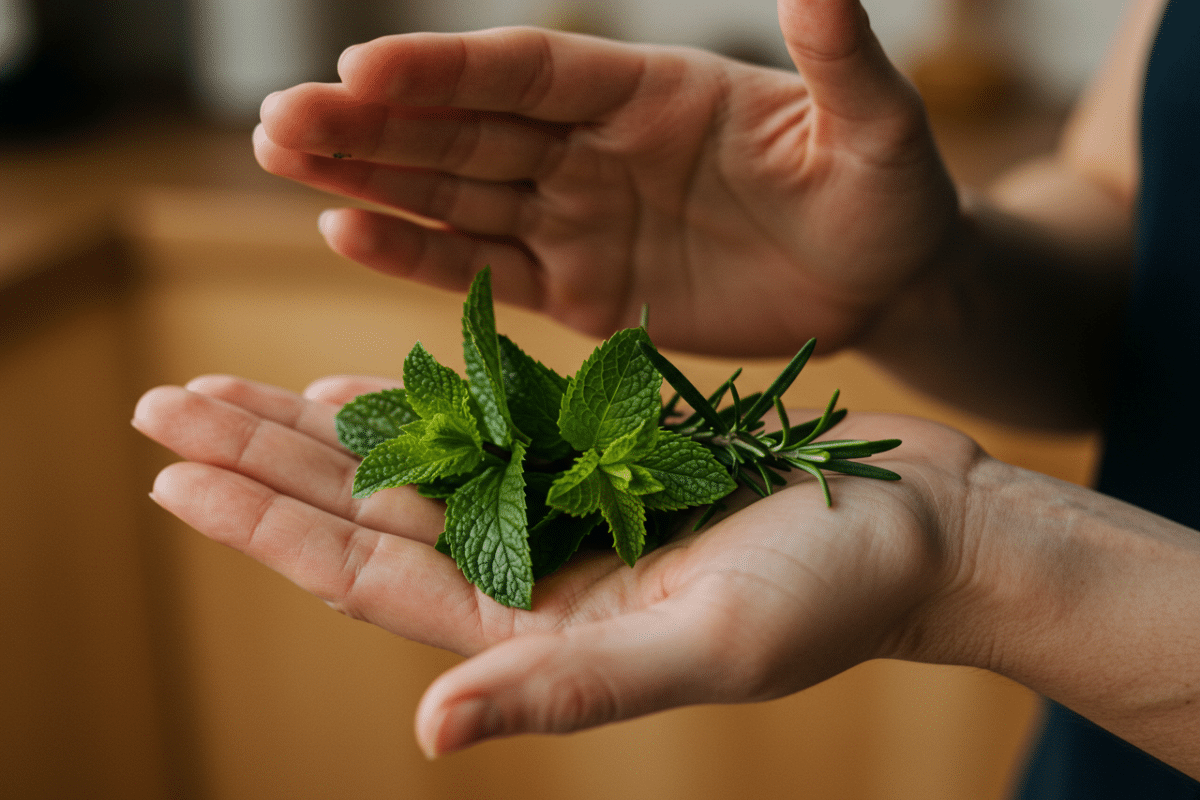
Step 2: Combine in Your Teapot or Mug
Transfer the awakened herbs into a mug or small teapot. If you’re using a clear vessel, you’ll see the leaves gently float as soon as the water hits—it’s a relaxing little moment.
Step 3: Steep to Perfection
Pour hot water (just off the boil) over the herbs and cover your mug or teapot. Let the tea steep for 5 to 7 minutes. The water will slowly turn a soft green as the steam carries a fresh, minty scent.
Step 4: Customize Your Cup
Stir in a teaspoon of honey or maple syrup, if you’d like a touch of sweetness. Add a slice of lemon for brightness or a little extra freshness. Adjust your add-ins based on your mood.
Step 5: Sip and Enjoy
You can strain the herbs out or leave them in for a more rustic-style cup. Take a moment to enjoy the aroma and warmth—this is one of those small, simple rituals that feels grounding anytime of day.
Peppermint Tea Variations & Add-ins
Iced Peppermint Tea Recipe
After steeping, let the tea cool to room temperature, then pour it over a glass filled with ice. Add a few fresh mint leaves and a lemon wheel for a spa-like touch. This version is perfect for warm days when you want something crisp and refreshing. If you enjoy cooling drinks, you might also like this easy copycat Starbucks Pink Drink recipe.
Peppermint Tea for Cough Relief
For a gentle, throat-soothing variation, add a teaspoon of honey and a small slice of fresh ginger while the tea steeps. Ginger brings a warm edge that pairs well with mint and may offer extra comfort when you’re feeling under the weather.
Peppermint Tea for Focus
To support clarity and focus, include the optional sprig of rosemary. A pinch of lavender buds or a thin slice of cucumber can add a calming, aromatic layer—great for study sessions or an afternoon reset.
Herbal Blends to Explore
Fresh peppermint blends beautifully with other herbs. Try chamomile for relaxation, lemon balm for a mellow, soothing cup, or spearmint for a slightly sweeter twist. This is an easy way to customize your tea for your mood or the season.
How to Serve and Store Your Homemade Tea
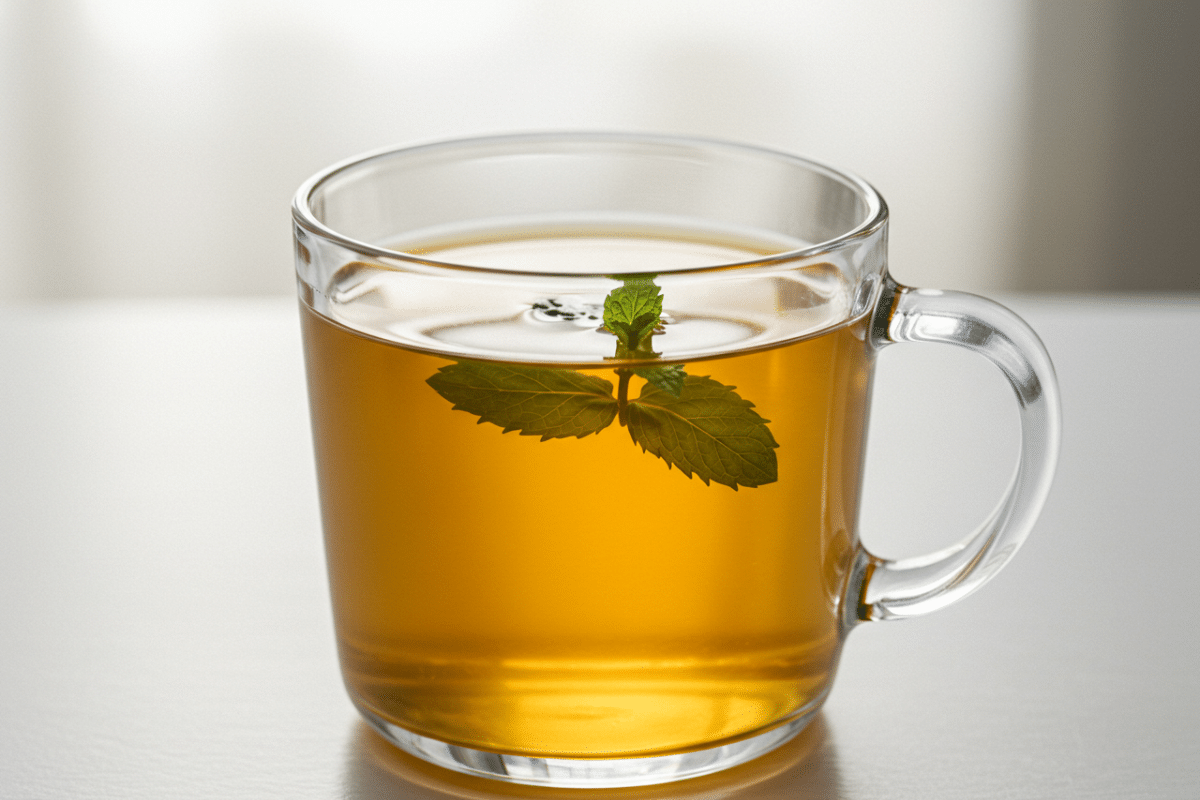
Best Time to Serve
This peppermint tea works beautifully any time of day—serve it hot in the morning as a gentle coffee alternative or enjoy it iced in the afternoon for a refreshing lift. It also makes a nice after-dinner option when you want something calming and light.
Presentation Tips
Add a fresh mint sprig or a twist of lemon peel for a simple, bright garnish. If you’re serving guests, clear glass mugs make the herbal color and floating leaves look especially inviting.
How to Store Leftovers
Let any leftover tea cool completely, then pour it into a sealed glass jar or bottle. Store it in the fridge for up to three days. It tastes great chilled on its own or poured over ice.
Batch Brew Like a Pro
Serving a crowd? Triple the ingredients and use a large teapot or heat-safe pitcher. Let the herbs steep fully, then serve right away or chill for a ready-to-pour iced version—perfect for brunches, picnics, or long workdays.
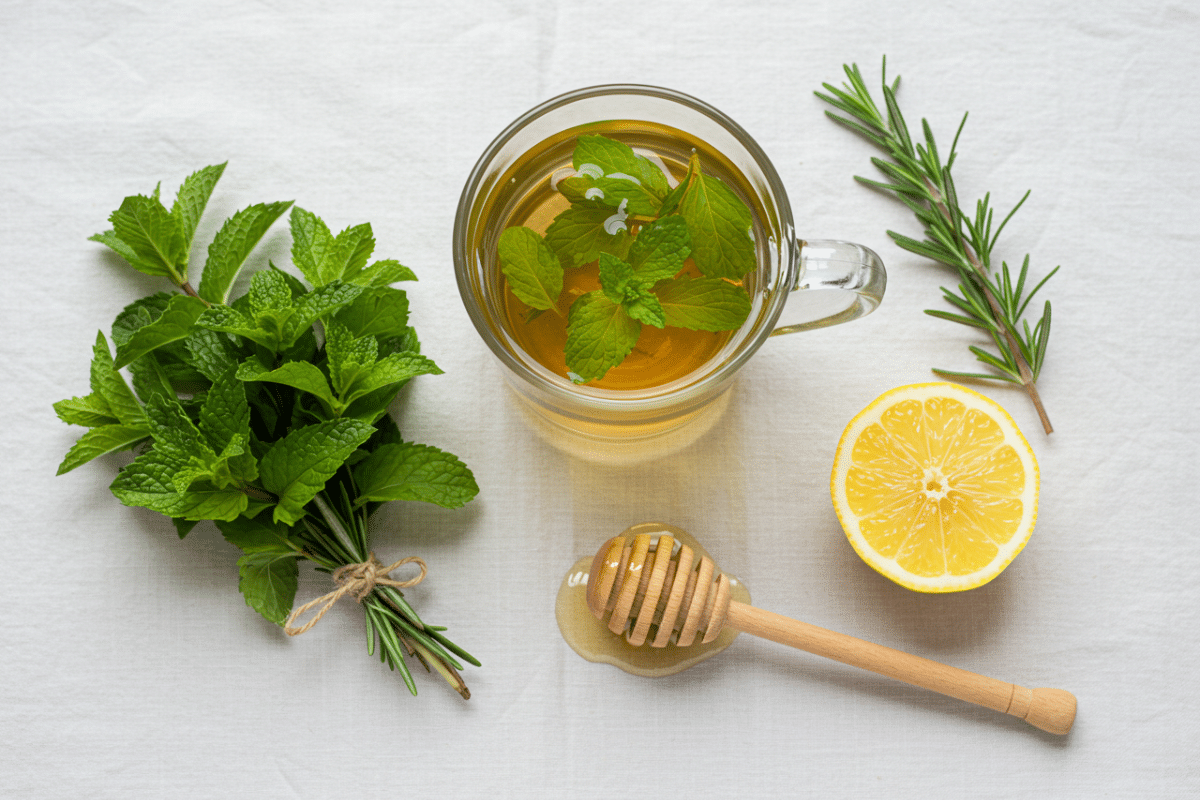
Fresh Peppermint Tea Recipe
Ingredients
- 2 cups of water just off the boil
- 1 generous handful of fresh peppermint leaves about 15–20 large leaves, rinsed
- 1 small sprig of fresh rosemary optional, for mental clarity
- 1 teaspoon of honey or maple syrup optional
- 1 slice of fresh lemon optional
Instructions
- Awaken the Herbs: Take the fresh peppermint leaves and the optional rosemary sprig and place them in the palm of your hand. Gently clap your other hand over them 2–3 times to release their fragrant oils.
- Combine: Place the awakened herbs into a mug or a small teapot.
- Infuse: Pour the hot (not boiling) water over the herbs. Let the tea steep for 5–7 minutes.
- Customize: Stir in the optional honey or maple syrup until dissolved. Add a slice of lemon for brightness.
- Enjoy: You can strain the leaves out before drinking or leave them in for a more rustic, potent infusion.
Notes
Conclusion
Whether you’re looking for focus, calm, or just a refreshing herbal moment in your day, this peppermint tea recipe delivers all of that with simple, soothing ease. It’s a small ritual that can brighten your mood and give you a gentle reset whenever you need it. Brew a cup, breathe in the minty aroma, and enjoy a quiet moment to yourself.
If you’re in the mood for another cozy, aromatic blend, you might also enjoy our Ayurvedic Cumin, Coriander, and Fennel Tea recipe.
FAQ
What are the side effects of peppermint tea?
Peppermint tea is generally well-tolerated, but in rare cases it may cause mild heartburn or allergies. If you have acid reflux or are pregnant, it’s a good idea to check with your healthcare provider before drinking it regularly.
Can I drink peppermint tea daily?
Yes, many people enjoy peppermint tea every day. It’s caffeine-free, hydrating, and gentle, making it a simple daily ritual for relaxation and comfort.
Should you crush mint leaves for tea?
It’s better not to crush them. Instead, gently clap the leaves between your palms to release their natural oils without creating bitterness.
Are you supposed to put milk in peppermint tea?
Peppermint tea is traditionally served without milk. Its clean, herbal flavor pairs more naturally with lemon or honey.
How to make peppermint tea for a cough?
You can add honey or a small slice of fresh ginger while the tea steeps. These ingredients blend well with mint and create a warm, soothing cup.
How long does it take for peppermint tea to work?
Everyone is different, but many people enjoy peppermint tea because it feels calming and refreshing shortly after drinking it.

